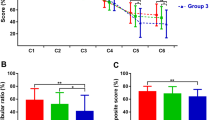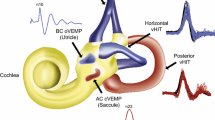Abstract
The objective of this retrospective study was to investigate the horizontal vestibulo-ocular reflex (hVOR) pathway with caloric test (low-frequency hVOR) and video head impulse test (vHIT) (high-frequency hVOR) in patients with sporadic vestibular schwannoma (69 patients, 27–86 years, mean age 58.1 years) and to compare both test methods in terms of their sensitivity and specificity to detect a retrocochlear lesion. Test results with a unilateral weakness (UWCaloric) >25 % (caloric test) or a Mean-GainvHIT <0.79/asymmetry ratio of Gain (AR-GainvHIT) >8.5 % and accompanied refixation saccades (vHIT) were considered abnormal. The overall sensitivity of the caloric test was 72 %. The evaluation of AR-GainvHIT detected more abnormal cases than did Mean-GainvHIT (44 vs. 36 %). In up to 4 %, a normal caloric test result was related to an abnormal vHIT. There was only a moderate correlation of UWCaloric and AR-GainvHIT (r = 0.54, p < 0.05) with a linear regression line intercept/slope of 32.2/0.9 (p < 0.05). Receiver operating characteristics curve analysis exhibited at a UWCaloric of 50 % a vHIT sensitivity/specificity/positive predictive value/negative predictive value of 0.45/0.9/0.94/0.42. Vestibular testing at varying frequencies provides deeper insights into hVOR function and is helpful in detecting a cerebello-pontine lesion. Whereas caloric test yields a high sensitivity for nerve dysfunction, vHIT test reveals a remaining function of hVOR in the high-frequency range.


Similar content being viewed by others
References
Agrawal Y, Schubert MC, Migliaccio AA, Zee DS, Schneider E, Lehnen N, Carey JP (2013) Evaluation of quantitative head impulse testing using search coils versus video-oculography in older individuals. Otol Neurotol 27
Weber KP, MacDougall HG, Halmagyi GM, Curthoys IS (2009) Impulsive testing of semicircular-canal function using videooculography. Ann N Y Acad Sci 1164:486–491
MacDougall HG, Weber KP, McGarvie LA, Halmagyi GM, Curthoys IS (2009) The video head impulse test: diagnostic accuracy in peripheral vestibulopathy. Neurology 73:1134–1141
Park HJ, Migliaccio AA, Della Santina CC, Minor LB, Carey JP (2005) Search-coil head-thrust and caloric tests in Menière`s disease. Acta Otolaryngol 8:852–857
Nguyen KD, Minor LB, Della Santina CC, Carey JP (2009) Vestibular function and vertigo control after intratympanic gentamicin for Menière`s disease. Audiol Neurootol 14:361–372
Zellhuber S, Mahringer A, Rambold HA (2013) Relation of video-head-impulse test and caloric irrigation: a study on the recovery in unilateral vestibular neuritis. Eur Arch Otorhinolaryngol 6
Mahringer A, Rambold HA (2013) Caloric test and video-head-impulse: a study of vertigo/dizziness patients in a community hospital. Eur Arch Otorhinolaryngol 15
Bartolomeo M, Biboulet R, Pierre G, Mondain M, Uziel A, Venail F (2013) Value of the video head impulse test in assessing vestibular deficits following vestibular neuritis. Eur Arch Otorhinolaryngol 29
Machner B, Gottschalk S, Sander T, Helmchen C, Rambold H (2007) Intralabyrinthine schwannoma affecting the low but not high frequency function of the vestibulo-ocular reflex: implications for the clinical diagnosis of chronic peripheral vestibular deficits. J Neurol Neurosurg Psychiatry 78:772–774
Formby C, Robinson DA (2000) Measurement of vestibular ocular reflex (VOR) time constants with a caloric step stimulus. J Vestib Res 10:25–39
Samii M, Matthies C (1997) Management of 1000 Vestibular schwannomas (acoustic neuromas): surgical management and results with an emphasis on complications and how to avoid them. Neurosurgery 40:11–23
Sills AW, Baloh RW, Honrubia V (1977) Caloric testing 2: results in normal subjects. Ann Otol Rhinol Laryngol Suppl 86:7–23
Perez N, Rama-Lopez J (2003) Head-impulse and caloric tests in patients with dizziness. Otol Neurotol 24:913–917
Schmid-Priscoveanu A, Bohmer A, Obzina H, Straumann D (2001) Caloric and search-coil head-impulse testing in patients after vestibular neuritis. J Assoc Res Otolaryngol 2:72–78
Halmagyi GM, Curthoys IS, Cremer PD, Henderson CJ, Todd MJ, Staples MJ, D’Cruz DM (1990) The human horizontal vestibulo-ocular reflex in response to high-acceleration stimulation before and after unilateral vestibular neurectomy. Exp Brain Res 81:479–490
Gilchrist DP, Curthoys IS, Cartwright AD, Burgess AM, Topple AN, Halmagyi M (1998) High acceleration impulsive rotations reveal severe long-term deficits of the horizontal vestibulo-ocular reflex in the guinea pig. Exp Brain Res 123:242–254
Lasker DM, Hullar TE, Minor LB (2000) Horizontal vestibulo-ocular reflex evoked by high-acceleration rotations in the squirrel monkey. III. Responses after labyrinthectomy. J Neurophysiol 83:2482–2496
Tringali S, Charpiot A, Ould MB, Dubreuil C, Ferber-Viart C (2010) Characteristics of 629 vestibular schwannomas according to preoperative caloric responses. Otol Neurotol 31:467–472
Baird RA, Desmadryl G, Fernandez C, Goldberg JM (1988) The vestibular nerve of the chinchilla. II. Relation between afferent response properties and peripheral innervation patterns in the semicircular canals. J Neurophysiol 60:182–203
Aw ST, Haslwanter T, Fetter M, Heimberger J, Todd MJ (1998) Contribution of the vertical semicircular canals to the caloric nystagmus. Acta Otolaryngol 118(5):618–627
Killian JE, Baker JF (2002) Horizontal vestibulo-ocular reflex (VOR) head velocity estimation in Purkinje cell degeneration (pcd/pcd) mutant mice. J Neurophysiol 87:1159–1164
Cohen H, Cohen B, Raphan T, Waespe W (1992) Habituation and adaptation of the vestibulo-ocular reflex: a model of differential control by the vestibulocerebellum. Exp Brain Res 90:526–538
Hirvonen M, Aalto H, Petteri Hirvonen T (2008) Motorized head impulse rotator in patients with vestibular schwannoma. Acta Otolaryngol 128:1215–1220
Blödow A, Pannasch S, Walther LE (2013) Detection of isolated covert saccades with the video head impulse test in peripheral vestibular disorders. Auris Nasus Larynx 40:348–351
Beynon GJ, Jani P, Baguley DM (1998) A clinical evaluation of head impulse testing. Clin Otolaryngol 23:117–122
Harvey SA, Wood DJ, Feroah TR (1997) Relationship of the head impulse test and head-shake nystagmus in reference to caloric testing. Am J Otol 18:207–213
Hamid M (2005) More than 50 % canal paresis is needed for the head impulse test to be positive. Otol Neurotol 26:318–319
Liu B, Kong WJ (2011) Evaluation of the vestibular ocular reflex in patients with unilateral peripheral vestibular disorder by the head impulse test. Zhonghua Er Bi Yan Hou Tou Jing Wai Ke Za Zhi 46:40–43
Kim HJ, Lee SH, Park JH, Choi JY, Kim JS (2014) Isolated vestibular nuclear infarction: report of two cases and review of the literature. J Neurol 261:121–129
Kattah JC, Talkad AV, Wang DZ, Hsieh YH, Newman-Toker DE (2009) HINTS to diagnose stroke in the acute vestibular syndrome: three-step bedside oculomotor examination more sensitive than early MRI diffusion-weighted imaging. Stroke 40:3504–3510
Straka H, Lambert FM, Pfanzelt S, Beraneck M (2009) Vestibulo-ocular signal transformation in frequency-tuned channels. Ann N Y Acad Sci 1164:37–44
Sadeghi SG, Chacron MJ, Taylor MC, Cullen KE (2007) Neural variability, detection thresholds, and information transmission in the vestibular system. J Neurosci 27:771–781
Conflict of interest
The authors declare no financial interest.
Author information
Authors and Affiliations
Corresponding author
Rights and permissions
About this article
Cite this article
Blödow, A., Blödow, J., Bloching, M.B. et al. Horizontal VOR function shows frequency dynamics in vestibular schwannoma. Eur Arch Otorhinolaryngol 272, 2143–2148 (2015). https://doi.org/10.1007/s00405-014-3042-2
Received:
Accepted:
Published:
Issue Date:
DOI: https://doi.org/10.1007/s00405-014-3042-2




